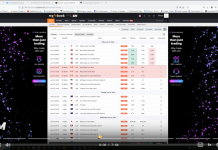Is any one better than the rest?
Inexperienced or novice traders often ask “which is the best chart?” That question is almost impossible to answer since, as with most things in trading, it comes down to personal preference and experience. It is likely that as a trader gains experience he may move to using more sophisticated tools and this applies to chart types as well.
I will attempt to give some guidance on the various types of chart available, what they show and how they can be used to enable you to make an informed decision.
Chart types
Each graph is nothing more than a visualization of the price of an instrument at specified time and over a specific time period.
Charting was always the domain of individual investors who were looking for a way to gain advantage over other traders on markets. One of the forerunners was Munehisa Homma, a trader dealing with rice in Japan. In the seventeenth century he developed candlestick charts.
He is among the group of legendary traders and this success in part is attributed to the use of so called Japan candles charts and Price Action.
However it is easy to understand that charts were created especially for visualizers, who form 90 than 90% of traders. A price on a chart is easier to track, creates an intuitive understanding of the assets behaviour than a sequence of numbers. First of all a graph creates a sequence of events, and people are used to connecting the events in sequences of cause and effect. The ability to visualize is a major benefit of charting the course of an asset or market.
Line graph
A line chart is the simplest type of chart. On the chart the value of the closing price in a given period over a specific period is plotted. Each value is connected by a line and a chart is created on which the closing price is plotted and all other values (open, high, low) in that period are ignored.

Many traders feel the benefit of this chart is that it is “cleaner” and contains less “noise” than other forms of chart.
Solid Chart
Filling in the area below the line on this chart provides a graph that is often called a “Manhattan” since it resembles the New York skyline.
This provides an additional visualization of a trend and is more commonly used in commodity, raw materials and stock trading.
Limitations applicable to a line chart also apply.
A bar chart
A bar chart is more sophisticated than a line chart. The bar shows us not only range of price movement, but also the first and last level of price in a given period of time.
Thus, the bar provides us with more information, such as: opening, high, low and closing (OHLC) in a given unit of time (eg. 1 hour).
It provides a clear advantage, because it provides more detail about what happened with price during formation of the bar. A bar chart also shows us the extent to which the transactions were performed, which may be important for determining levels of support/resistance and to properly place Stop Loss or Take Profit levels.
A disadvantage of the bars may be that the dominant information is range of price movement, while the opening and closing of each bar is not so clear to see. Bar charts are particularly interesting when trading on lower intervals, demonstrating swings and price patterns while blurring formations composed of individual bars.

Candlestick chart
A bar chart is more sophisticated than a line chart. The bar shows us not only range of price movement, but also the first and last level of price in a given period of time.
Thus, the bar provides us with more information, such as: opening, high, low and closing (OHLC) in a given unit of time (eg. 1 hour).
It provides a clear advantage, because it provides more detail about what happened with price during formation of the bar. A bar chart also shows us the extent to which the transactions were performed, which may be important for determining levels of support/resistance and to properly place Stop Loss or Take Profit levels.
A disadvantage of the bars may be that the dominant information is range of price movement, while the opening and closing of each bar is not so clear to see. Bar charts are particularly interesting when trading on lower intervals, demonstrating swings and price patterns while blurring formations composed of individual bars.

Renko Chart
More experienced traders study Renko charts.
This type of chart is based solely on volatility, there is no time factor.
Each brick is the same width, but the forming time of individual building bricks can be diametrically different. These bricks are sometimes referred to as “blocks” or “boxes.”
Every Brick has a set number of pips and every time the price moves by that set amount, a new brick is added. The proportion of bricks is entirely dependent upon volatility on a chart you may have twenty brick in a period. The next period of similar length may have just two.
Classical analysis tools don’t work on a Renko chart that gives it mystique but also concerns traders not used to not having their regular tools to hand. It is no use to a trader who relies on sentiment since the trend is visible but the time isn’t.

There is no simple answer. An experienced trader may rely on a line chart simply because it gives him what he needs and a novice my look at a Renko chart and see in it what he needs to justify his trading style.



















